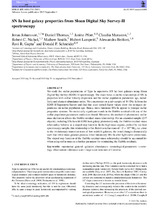| dc.contributor.author | Johansson, Jonas | |
| dc.contributor.author | Thomas, Daniel | |
| dc.contributor.author | Smith, Mathew | |
| dc.contributor.author | Pforr, Janine | |
| dc.contributor.author | Maraston, Claudia | |
| dc.contributor.author | Nichol, Robert C. | |
| dc.contributor.author | Lampeitl, Hubert | |
| dc.contributor.author | Beifiori, Alessandra | |
| dc.contributor.author | Gupta, Ravi R. | |
| dc.contributor.author | Schneider, Donald P. | |
| dc.date.accessioned | 2017-07-25T09:59:09Z | |
| dc.date.available | 2017-07-25T09:59:09Z | |
| dc.date.issued | 2013 | |
| dc.identifier.citation | Johansson, J. et al. (2103). SN Ia host galaxy properties from Sloan Digital Sky Survey-II spectroscopy. Monthly Notices of the Royal Astronomical Society, 435: 1680–1700 | en_US |
| dc.identifier.issn | 0035-8711 | |
| dc.identifier.uri | http://hdl.handle.net/10566/3106 | |
| dc.description.abstract | We study the stellar populations of Type Ia supernova (SN Ia) host galaxies using Sloan
Digital Sky Survey (SDSS)-II spectroscopy. The main focus is on the relationships of SN Ia
properties with stellar velocity dispersion and the stellar population parameters age, metallicity
and element abundance ratios. We concentrate on a sub-sample of 84 SNe Ia from the
SDSS-II Supernova Survey and find that SALT2 stretch factor values show the strongest dependence
on stellar population age. Hence, more luminous SNe Ia appear in younger stellar
progenitor systems. No statistically significant trends in the Hubble residual with any of the
stellar population parameters studied are found. Moreover, the method of photometric stellar
mass derivation affects the Hubble residual–mass relationship. For an extended sample (247
objects), including SNe Ia with SDSS host galaxy photometry only, the Hubble residual–mass
relationship behaves as a sloped step function. In the high-mass regime, probed by our host
spectroscopy sample, this relationship is flat. Below a stellar mass of ∼2 × 1010M , i.e. close
to the evolutionary transition mass of low-redshift galaxies, the trend changes dramatically
such that lower mass galaxies possess lower luminosity SNe Ia after light-curve corrections.
The sloped step function of the Hubble residual–mass relationship should be accounted for
when using stellar mass as a further parameter for minimizing the Hubble residuals. | en_US |
| dc.language.iso | en | en_US |
| dc.publisher | Oxford University Press | en_US |
| dc.rights | Publisher retains copyright. Authors may archive the published version in their institutional repository. | |
| dc.source.uri | http://dx.doi.org/10.1093/mnras/stt1408 | |
| dc.subject | Supernovae | en_US |
| dc.subject | General – galaxies | en_US |
| dc.subject | Abundances | en_US |
| dc.subject | Cosmological parameters | en_US |
| dc.subject | Cosmology | en_US |
| dc.subject | Observations | en_US |
| dc.subject | Distance scale | en_US |
| dc.subject | Large-scale structure of Universe | en_US |
| dc.title | SN Ia host galaxy properties from Sloan Digital Sky Survey-II spectroscopy | en_US |
| dc.type | Article | en_US |
| dc.description.accreditation | Department of HE and Training approved list | |

